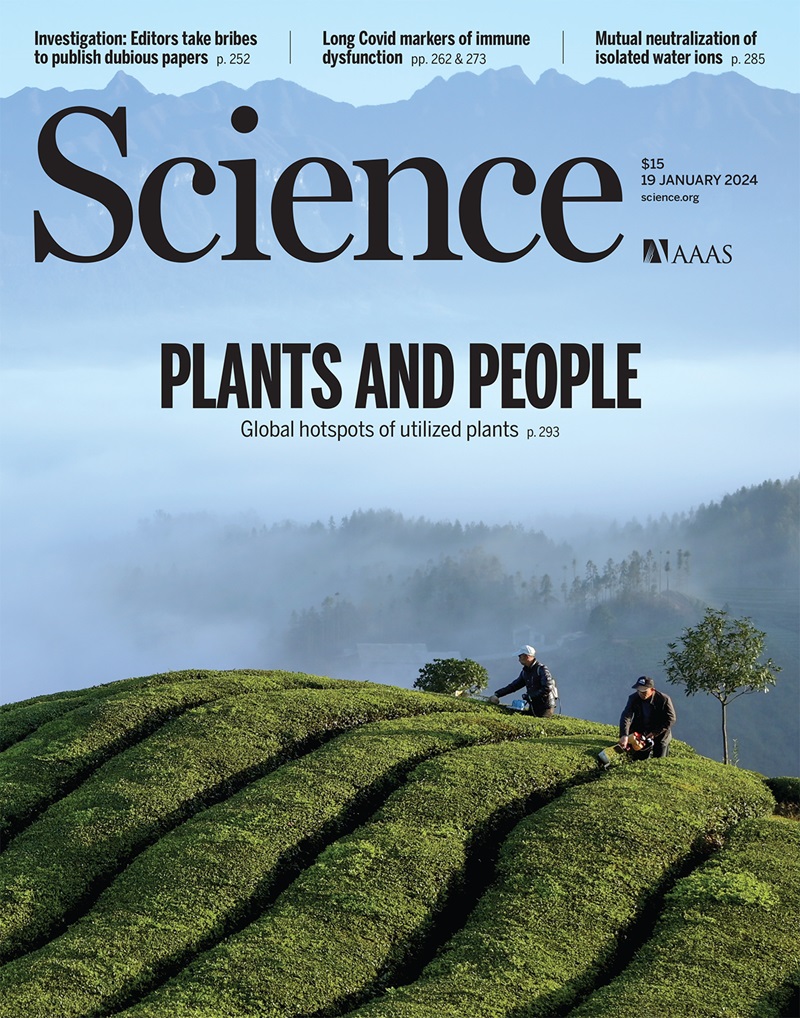VPS15在自噬中调控pi3激酶的结构途径
IF 45.8
1区 综合性期刊
Q1 MULTIDISCIPLINARY SCIENCES
引用次数: 0
摘要
III类磷脂酰肌醇-3激酶复合物I和II (PI3KC3-C1和-C2)分别在巨噬和内体成熟中起重要作用。我们通过低温电镜分析阐明了PI3KC3-C1酶活化的结构途径。VPS15伪激酶的非活性构象稳定了非活性构象,将其肉豆蔻酸酯隔离在伪激酶的N叶中。激活后,肉豆蔻酸酯被释放,使VPS34脂质激酶催化膜上PI3P的产生。VPS15伪激酶结构域与鸟苷三磷酸(GTP)紧密结合,并稳定相互作用网络,自抑制胞质复合物并促进膜结合时的激活。这些发现在原子细节上显示了VPS34脂质激酶是如何在一个完整的PI3K复合物的背景下被激活的。本文章由计算机程序翻译,如有差异,请以英文原文为准。

Structural pathway for PI3-kinase regulation by VPS15 in autophagy
The class III phosphatidylinositol-3 kinase complexes I and II (PI3KC3-C1 and PI3KC3-C2) have vital roles in macroautophagy and endosomal maturation, respectively. We elucidated a structural pathway of enzyme activation through cryo–electron microscopy analysis of PI3KC3-C1. The inactive conformation of the VPS15 pseudokinase stabilizes the inactive conformation, sequestering its N-myristate in the N-lobe of the pseudokinase. Upon activation, the myristate is liberated such that the VPS34 lipid kinase catalyzes phosphatidylinositol-3 phosphate production on membranes. The VPS15 pseudokinase domain binds tightly to guanosine triphosphate and stabilizes a web of interactions to autoinhibit the cytosolic complex and promote activation upon membrane binding. These findings show in atomistic detail how the VPS34 lipid kinase is activated in the context of a complete PI3K complex.
求助全文
通过发布文献求助,成功后即可免费获取论文全文。
去求助
来源期刊

Science
综合性期刊-综合性期刊
CiteScore
61.10
自引率
0.90%
发文量
0
审稿时长
2.1 months
期刊介绍:
Science is a leading outlet for scientific news, commentary, and cutting-edge research. Through its print and online incarnations, Science reaches an estimated worldwide readership of more than one million. Science’s authorship is global too, and its articles consistently rank among the world's most cited research.
Science serves as a forum for discussion of important issues related to the advancement of science by publishing material on which a consensus has been reached as well as including the presentation of minority or conflicting points of view. Accordingly, all articles published in Science—including editorials, news and comment, and book reviews—are signed and reflect the individual views of the authors and not official points of view adopted by AAAS or the institutions with which the authors are affiliated.
Science seeks to publish those papers that are most influential in their fields or across fields and that will significantly advance scientific understanding. Selected papers should present novel and broadly important data, syntheses, or concepts. They should merit recognition by the wider scientific community and general public provided by publication in Science, beyond that provided by specialty journals. Science welcomes submissions from all fields of science and from any source. The editors are committed to the prompt evaluation and publication of submitted papers while upholding high standards that support reproducibility of published research. Science is published weekly; selected papers are published online ahead of print.
 求助内容:
求助内容: 应助结果提醒方式:
应助结果提醒方式:


